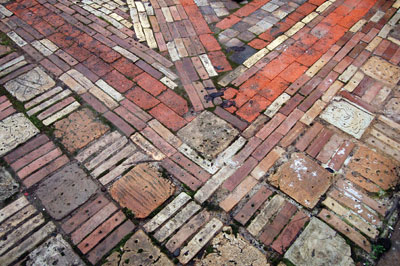
In relationship to the ceramics studio, there are two distinct areas for improvement when it comes to waste. Overall the amount and type of resources used can be considered. More specifically, the chemical makes up of our raw materials should be accounted for so that we can protect our environment from contamination.
Reuse – Recycle – Repurpose
Sustainability and the Ceramics Studio – Article by Kristin Schimik in Ceramics Arts Daily. Three Universities share their creative disposal methods in the studio including producing the paver bricks seen above out of studio by-products. A great example of repurposing!
Up-Cycle Reclaim Clay & Glaze – Deb Schwartzkopf’s video on how she makes pavers out of ceramic waste.
Ten Tips for Reducing Studio Waste – NCECA Green Taskforce has put together these tips on how to decrease studio waste.
Sink Sludge – Clay Matters alternative to disposal of sink trap material waste.
Hazardous Waste and Disposal
*See Chapter 5 : Chemicals: Use and Disposal for a broader guide to chemicals in the studio.
Some of the materials that are used in ceramics elements are considered Hazardous Waste by the Environmental Protection Agency (EPA). Of the regulated elements, we encounter 4 of them:
- Lead – Lead is found in leaded frits
- Barium
- Cadmium – is found primarily in red and orange stains.
- Chrome – found in oxide form and stains
These chemicals remain an environmental liability and it is required that they are handled in accordance with federal, state, and local laws. Hazardous materials must be disposed of in hazardous waste drums to ensure they will not seep into the water supply of your community. When using commercial glazes, check the container for the toxicity label.
In a private studio environment, it is your neighborly responsibility to ensure your practice does not negatively impact the safety of your surrounding community. Ideally, you would maintain a sink designated for your hazardous materials. This sink should trap hazardous materials which could then be stored until dropped off at your local hazardous materials and waste management facility, which can be found with a simple internet search. [1]
Check out this ceramics-specific sink trapping system called the Cink.
The Dirty Nineteen
Use this list to understand what common ceramic materials should not go down the drain. This is not a comprehensive list but illustrates that hazardous materials can exist in small percentages in an unassuming material. The following chemicals should be disposed of as hazardous chemicals and kept from going down the drain or seeping into the soil.
- Albany Slip Substitute (Lead Compound)
- Barium Carbonate
- Cadmium Pigments
- Chromium Oxide
- Copper Oxide
- Light Rutile (Chromium Oxide)
- Dark Rutile (Chromium Oxide)
- Granular Rutile (Chromium Oxide)
- Frit #3403 (Lead Compound)
- Frit #3626 (Lead Compound)
- Frit #3304 (Lead Compound)
- Black Iron Oxide (Arsenic/Nickel)
- Lead Chromate
- Nickel Carbonate
- Black Nickel Oxide
- Strontium Carbonate (Barium Carbonate)
- Zinc Oxide (Lead, Cadmium)
- Frit #VO6129 (Lead-Cadmium Compound)
- Iron Chromate (Chrome Ore)